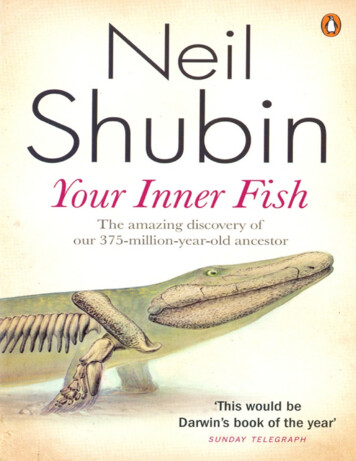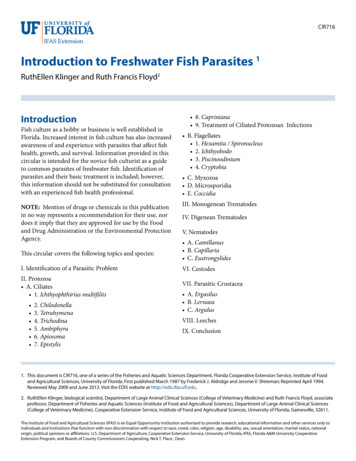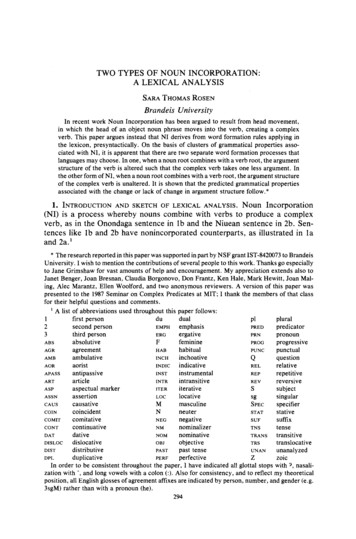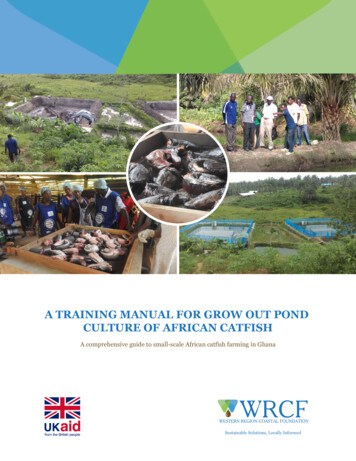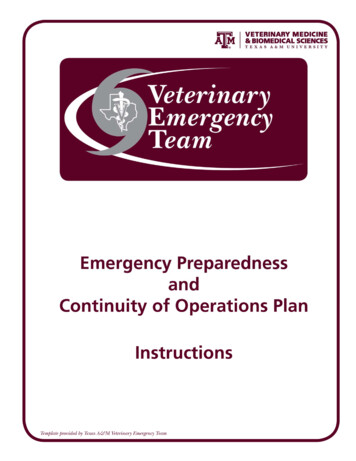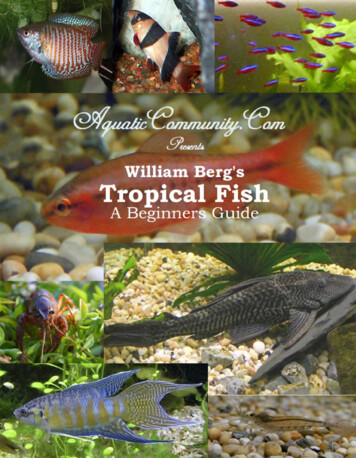
Transcription
AC Tropical am Berg'sTropical FishA Beginners GuideCopyright 2005 William Berg & AC Tropical FishAll materials contained in this e-book are the property of William Berg & AC Tropical Fish(aquaticcommunity.com). The following rules apply to reproduce, modify, distribute or republish materialscontained in this book.Aquarium organizationsWe welcome aquarium organisations to republish printed versions of this e-book if they wish to distribute it totheir members. We do however ask that you send a copy to AC Tropical fish and if possible post a link to ACTropical Fish (http://www.aquaticcommunity.com) on the organizations web site. Contactadmin@aquaticcommunity.com for the address to which to send the copy of the print. Aquarium organisationsmay not modify the content, alter or remove any trademark, copyright or other notice from copies of contentwithout or written permission.If aquarium organisations wish to give their members a digital copy of the e-book, it must be offered via a link toAc tropical fish main page or to the download page where each member can download their own copy.Fish storesFish stores, pet stores and other commercial entities may produce printed copies of this e-book or section thereofas a free service to their customers. You are not allowed to charge the customers for reprints. You may notmodify the content, alter or remove any trademark, copyright or other notice from copies of content.Websites and Internet useYou may not reproduce any part of this e-book on your website or otherwise online without our permission. Ifyou want to share this e-book with other aquarists, please send them a link to the download page from wherethey can download their own copy of the e-book. You are also very welcome to post a link to AC Tropical Fish(http://www.aquaticcommunity.com) on your homepage, blog, or in aquarium forums.You may not reproduce, modify, distribute or republish materials contained in this book without our writtenpermission in other situations than those mentioned above.Please contact admin@aquaticcommunity.com if you would like permission to use the e-book or parts thereof inanother way than those described above.Pictures:The pictures used on the front page of this book are public domain or released under the GNU FreeDocumentation License, Version 1.2.
Tropical fish - a beginner's guideTropical fish - a beginner's guide is made available for free download by AC Tropical Fish(aquaticcommunity.com). By offering this comprehensive guide to successful fish keeping forbeginners, we hope to increase the number of happy successful aquarists – and healthy fish!All aquarists are welcomed to download their own free version of Tropical fish - a beginner'sguide from our website. And we would like to ask you to help us to spread the word about thisguide to all prospective beginner aquarists out there.We are planning for this e-book to be the first in a series of free e-books written to helpaquarists give their fish a good home and allow them to get the most out of their hobby. Thework on a second book in the series about Betta fish (Siamese fighting fish) has alreadybegun. The future of the series is however partly dependent on the success of the first twobooks since their will be little meaning for us to devoted the considerable time required towrite and edit an e-book like this if no one are interested in reading it. We would thereforelike to ask for your help to spread the word of this e-book by linking to it from your blog orhomepage and by telling your aquarist friends on forums and your offline friends about the ebook and the fact that it can be downloaded from AC Tropical Fish (aquaticcommunity.com).You can find codes that you can use to link to our site and thereby supporting our workbelow. You are of course welcome to use any other code to link to us as well.HTML code suitable for blogs and homepages, including Livejournal / Blogspot, MSNSpaces, MySpace, The Facebook and Yahoo 360 / Xanga: a href ”http://www.aquaticcommunity.com” Tropical fish – a beginners guide /a a href ”http://www.aquaticcommunity.com” Free Tropical fish e-book /a BBCode to be used in forums:[url http://www.aquaticcommunity.com] Tropical fish – a beginners guide [/url][url http://www.aquaticcommunity.com] Free Tropical fish e-book [/url]
Chapter 1. 7How to set up an aquarium . 7Choosing a spot for your aquarium. 8Choosing an aquarium . 9Acrylic or Glass Aquarium . 9Putting the aquarium in place . 10Choosing equipment . 10Lighting. 10Heating. 11Filtration. 11- Mechanical filtration. 11- Chemical filtration. 12- Biological filtration. 12- Other types of filtration . 12Air Pumps . 13Decorations . 13Plants. 15Water test kit . 16Setting up the aquarium . 17Water chemistry . 19Conditioning water. 21Cycling. 22Adding Fish. 23Stress in your aquarium . 26Water problems and their solutions . 27Tropical fish aquarium problems . 28Vacation care for your fish . 29Safety . 30Chapter 2 – Plants . 33Choosing plants for your aquarium. 33Factors that affect plant growth . 35Water. 35Lighting. 36Substrate. 36Nutrients. 37Filtration. 38Suitable plants for beginners. 38Caring for plants . 39Propagating plants. 41Algae . 42Chapter 3 - Fish. 44Choosing Fish . 44Biotopes . 45The Root biotope of South America . 46The Asian Lowland Still water Biotope. 46The Community Aquarium . 46Courtesy of Aquaticcommunity.com4
Chapter 4 - Aquarium Maintenance. 50Daily routine . 50Checking the fish . 50Checking the water . 51Checking the Filter. 51Feeding the fish. 52Weekly Routine . 52Monthly Routine . 54The “Old Aquarium” Syndrome . 54Filtration. 55Chapter 5 - Food . 58Feeding Fish. 58Flavor and taste . 59Sound . 59Smell . 59Color and Buoyancy of food. 59Understanding feeding and digestion in fish . 59Protein . 61Fatty acids . 61Fat-soluble carotenoid. 61Carbohydrates . 61Vitamins and minerals . 61Types of food . 62Live foods . 63Cultivation of some common live food . 64Feeding Fry . 65Feeding Habits . 66Chapter 6 - Breeding Fish . 69Spawning Methods. 69Egg Scatterers . 69Egg Depositors. 69Mouth Brooders . 70Nest Builders. 70Livebearers. 70Equipment management while breeding fish. 71Choosing the parents. 72Conditioning the parents . 73Tips for effective breeding. 74Raising Fry. 75Failure in Reproduction . 76Chapter 7 – Diseases. 78Buying healthy fish . 78Prevent diseases . 79Quarantine Aquarium. 80Columnaris. 81Gill Disease. 81Courtesy of Aquaticcommunity.com5
Ick . 81Dropsy. 82Fin-rot . 82Fungal Infections . 82Hole in the Head . 82Pop-Eye. 83Cloudy Eye. 83Swim Bladder Disease . 83Fish Lice. 83Nematode Worms . 83Water Quality Induced Diseases. 83Treating Fish . 84Courtesy of Aquaticcommunity.com6
Chapter 1Have you been thinking of adding a freshwater aquarium to your home? It's a lovely wayto enjoy a miniature riverbed from the comforts of your own room. A beautiful aquariumwith healthy, energetic fish swimming in clear waters and surrounded by green vegetationis a stunning sight. But before you begin, you need to be armed with all the relevant facts.As a person who has spent more than 20 years in this hobby, I have tried and tested manyof the tips, secrets and methods you will find in these pages. Setting up an aquarium isnot really a science but needs to be done correctly to give your fish the best possiblehome. It needs a little bit of common sense and foresight. There are many dos and don'tsthat are learnt over a long period of trial and error.This book is written mainly for beginners and I have therefore tried to keep things on avery basic level and use a language that is easy to understand. By following these basicinstructions you will be able to successfully set up and maintain a freshwater aquariumwith easy or moderately difficult fish species. It is important to keep in mind thatdifferent fish has different demands and this book does only give you basic knowledgeabout aquarium keeping. It is advisable to start out with comparatively easy fish speciesbefore you advance to more delicate ones. A lot of fish species have intricate demandsand in order to successfully keep such species you will need to research them morethoroughly. There is however a lot of beautiful and interesting fish species to chooseamong even for the novice aquarist, and by following the instructions in this book youwill be capable of successfully keeping a beautiful aquarium filled with thrivingvegetation and healthy and colorful fish.How to set up an aquariumAn aquarium, to put it simply, is a container that can sustain fish and other aquatic life fora longer period of time. Acquiring a good aquarium for your fish is not a very difficultjob as long as you give it some thought before you actually get it. There are some obviousconsiderations to be taken into account. Setting up and fully stocking a good aquariumwill take anywhere between a couple of weeks and a month. The time that you spend withthese basic steps will save you a lot of time and trouble at a later stage.There are several things to consider before you purchase an aquarium. How much timeyou are willing to spend on the aquarium? What kind of aquarium do you want to buy?What is the ideal spot for your aquarium? What kind of fish should you put in youraquarium? How do you keep your fish and their environment healthy in the easiest andquickest way? How much time would it all take to maintain? What should you feed yourfish and how much? What should you do when diseases strike? These are just some of themany questions that you need to think about.Courtesy of Aquaticcommunity.com7
A good and well stocked aquarium needs quite a bit of equipment. Here is a simple list ofthe items that you will need for a basic freshwater aquarium:¾¾¾¾¾¾¾¾¾¾¾An aquarium tankAn aquarium standA hoodLighting equipmentAir pumpHeaterThermometerFilters (internal or external)GravelDecorations (optional, but interesting if you have these)Maintenance items like scrubber, siphon tube etc.Choosing a spot for your aquariumFirst, you will need to think about how much free space you have for your aquarium,whether that free space is open to sunlight, and which shape that is best suited for thatfree space. Never place an aquarium in direct sunlight and keep the aquarium away fromany heating or cooling surfaces. Sunlight and heating or cooling surfaces will causesudden and drastic changes in the temperature within the aquarium, and sunlight will alsopromote the growth of algae in the water.Keep your aquarium away from machines that give out a lot of sound or cause vibration,like the washing machine, since this will stress the fish. Water accessibility and easydisposal of dirty water and waste are some other important factors to consider whileselecting a good spot for your aquarium as you don’t want to run around with buckets ofwater in your entire house. You will need to clean and change water at least monthly andbetter once a week. So, choose a place where you can work easily and without anyinterference. In a family with children, special care has to be taken to keep the aquariumaway from areas of frequent activity. You do not want your children to push or fall on theaquarium while they play and injure themselves or break the aquarium glass.Any good home has a certain décor. While choosing a spot for your aquarium, you mustconsider whether the general décor and lighting in the room will make it an attractiveplace for the new aquarium. Take the type of biotope you plan to have in your aquariuminto consideration when you decide if an aquarium will work with the décor of the chosenspot. Different types of biotopes works with different decors. A saltwater reef aquariumwill for instance have a very different look than a well planted South American biotope.You should also consider that an aquarium is very heavy so the chosen spot has to be ableto support the weight of the aquarium. Any aquarium over 10 gallons/ 40 L will weigh atleast a hundred and fifty pounds / 70 Kg when filled and decorated. The weight comeschiefly from the glass and the water, and decoration such as gravel will further add to thisCourtesy of Aquaticcommunity.com8
weight. Heavy aquariums will need to be kept on a sturdy stand rather than a shelf or adesk.Choosing an aquariumHow big should your aquarium be? Aquariums come in many shapes and sizes. It isadvisable to choose an aquarium that is at least 10 gallons/ 40 L, since small aquariumsare much more difficult to maintain. The waste build up in small aquariums is quick andquite large in comparison with a larger aquarium. A small aquarium will therefore requirevery frequent water changes. Changes in temperature or water chemistry will also takeplace more quickly in small aquariums. Rapid changes in the temperature or waterchemistry are harmful for fish.I would recommend a 30-gallon/120 L aquarium to novice aquarists, since this willprovide enough room for more fish and is easier to maintain as it has enough watervolume to dilute fish waste. A larger aquarium will naturally be even easier to maintain,but the benefits of an aquarium that is larger than 30-gallon/120 L is not as significant asthe difference between a 30-gallon/120 L aquarium and a smaller one. A 30-gallon/120 Laquarium is large enough to buffer against to rapid changes in water values. 30gallon/120 L is therefore an ideal beginner size.Fish aquariums come in many shapes ranging from rectangular to hexagonal or evencylindrical. While making your purchase, it is not only the beauty of the piece thatcounts. Mundane matters like how easy it will be to clean out the aquarium regularly, andhow to keep all the nooks and crannies hygienic are important considerations.The height of the aquarium is also a very important aspect. An aquarium that is very deepis complicated to keep for the beginner aquarist. Increased height means greater difficultywhen cleaning and your aquarium might therefore always carry some amounts of wasteeven after a thorough clean up. Poor light penetration is another problem with a deepaquarium. Plants will not thrive in water that has poor light penetration and speciallighting is therefore needed in deep planted aquariums.Acrylic or Glass AquariumGlass aquariums usually cost less and do not get scratches as easily as acrylic aquariums.Glass aquariums are also stronger, as they are bonded together by a silicone sealant. Theyneed support only on the edges, unlike acrylic aquariums. Glass aquariums are verydurable, and can last for many years without any problems. Proper lighting will makeglass aquariums look almost as clear as acrylic ones. On a negative note can be said thatglass aquariums are always much heavier than acrylic.However, if you are looking for irregular shapes, than these are easier to obtain as acrylicaquariums. Acrylic aquariums are much clearer than glass, and have better insulation.This means that you can use a smaller heater in your aquarium to maintain the propertemperature. Acrylic aquariums do however scratch easily and can therefore only beCourtesy of Aquaticcommunity.com9
cleaned with specially made soft pads. Removing scratches from acrylic aquariums canbe quite a troublesome procedure.The price can also be an important factor when it comes to buying your first aquarium.Glass aquariums are usually the cheaper alternative and there is also a wider selection ofsecond hand glass aquariums than there is of second hand acrylic aquarium since glassaquariums are more durable.Putting the aquarium in placeWhen you have selected the best aquarium for your needs, it is time to take it home. Hereis a checklist that you need to consider:¾Look for any scratches on the aquarium before you makethe purchase.¾Test to see if there are any leaks in the aquarium.¾Take care not to load any heavy items inside the aquariumwhile you carry it home. This may lead to scratching or evenbreakage.Get a tight fitting hood for the aquarium when you buy it. An open aquarium is never ahealthy option. More water will evaporate form an aquarium where the water is open tosunlight, heat etc. Evaporation will lead to the water becoming concentrated with wasteand animal- and plant debris, and can also cause water damages and mildew in the roomaround the aquarium. Contamination from falling waste is another problem. With an openaquarium you will also risk casualties since fish often jump out of an open aquarium, andending up on the floor is more often than not fatal for the fish unless you immediatelyspot it and put it back in the aquarium. Thus an aquarium needs a good and sturdy hood.These hoods come in various decorative shapes and colors.There are various accessories that go with your aquarium, other than the hood. Anaquarium is a complete set of a number of equipment that works together.Choosing equipmentLightingThe first equipment that you will come across is probably the lighting for the aquarium.Most hoods come with fluorescent or incandescent lighting. Fluorescent bulbs are a betterchoice despite the fact that they are a bit more expensive since they have long-termbenefits. They burn cooler, thereby not affecting the water temperature at all. Fluorescentbulbs have another benefit as they uses less electricity. Fluorescent bulbs can bepurchased in sizes that cover the entire aquarium. This will provide even lighting in allareas of the aquarium. There are a wide variety of fluorescent bulbs that emit differentspectrums of light. Some of these will even assist plant growth. Some will lead to anincrease in algae growth. Optimal plant growth requires a particular wattage, which canbe decided by the size of the aquarium. Usually, 1 gallon of water will require 1.5 watts.Courtesy of Aquaticcommunity.com10
An average aquarium requires 8 to 10 hours of light a day. If you use incandescentlighting it is however better to turn on the lighting for a few fixed hours a day. Especiallyin the case of smaller aquariums, the water will become considerably hotter during theday. And at night, once the light is switched off, the temperature of the water will dropfast.HeatingA thermostatically controlled water heater will help to maintain a regular watertemperature in the aquarium. This is especially good in areas that get very hot during theday and cool off during the nights. The more wattage your heater has, the more heat itwill generate. Larger aquariums need more heat than smaller ones as there is more waterto heat. An immersible heater hangs into the water while the thermostat remains abovewater. This makes it easier to take readings. Fully submersible heaters are fixed to theback wall of the aquarium. In this case, one has to be very careful while taking thereadings. Carelessness can cause the glass of the heater to crack or even explode.Even in places where the temperature is relatively stable, the use of a heater is stillrecommended, and required if you keep tropical fish. Only fish that do well in cold waterlike goldfish should be kept in aquariums without heaters. The heater will help you tocontrol the temperature in which the fish live. Even the hardiest of fishes cannot toleratesteep fluctuations in water temperature and will eventually die if they are submitted tosuch changes. It is therefore essential to have a thermometer
Ac tropical fish main page or to the download page where each member can download their own copy. Fish stores Fish stores, pet stores and other commercial entities may produce printed copies of this e-book or section thereof as a free service to their customers. You are not
